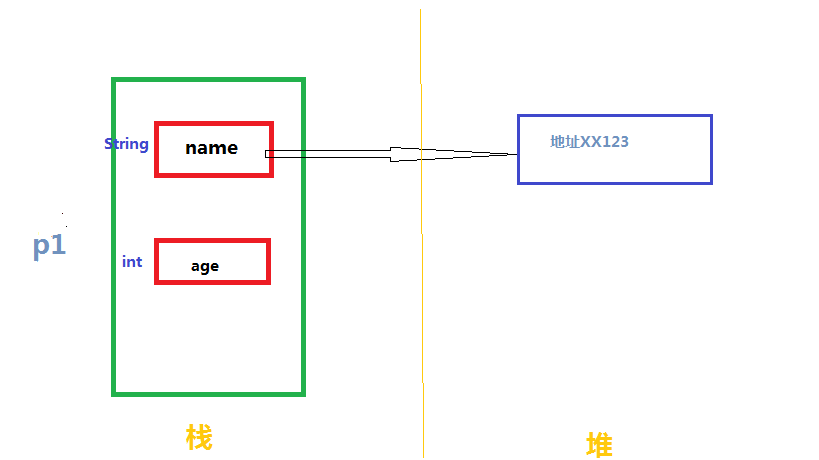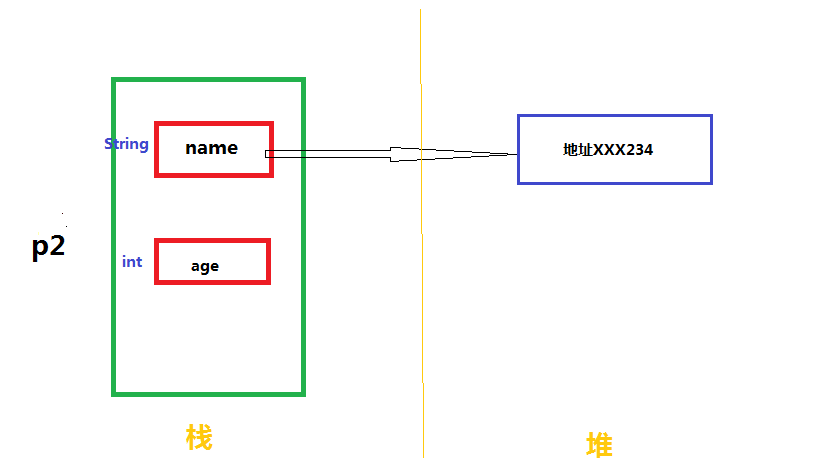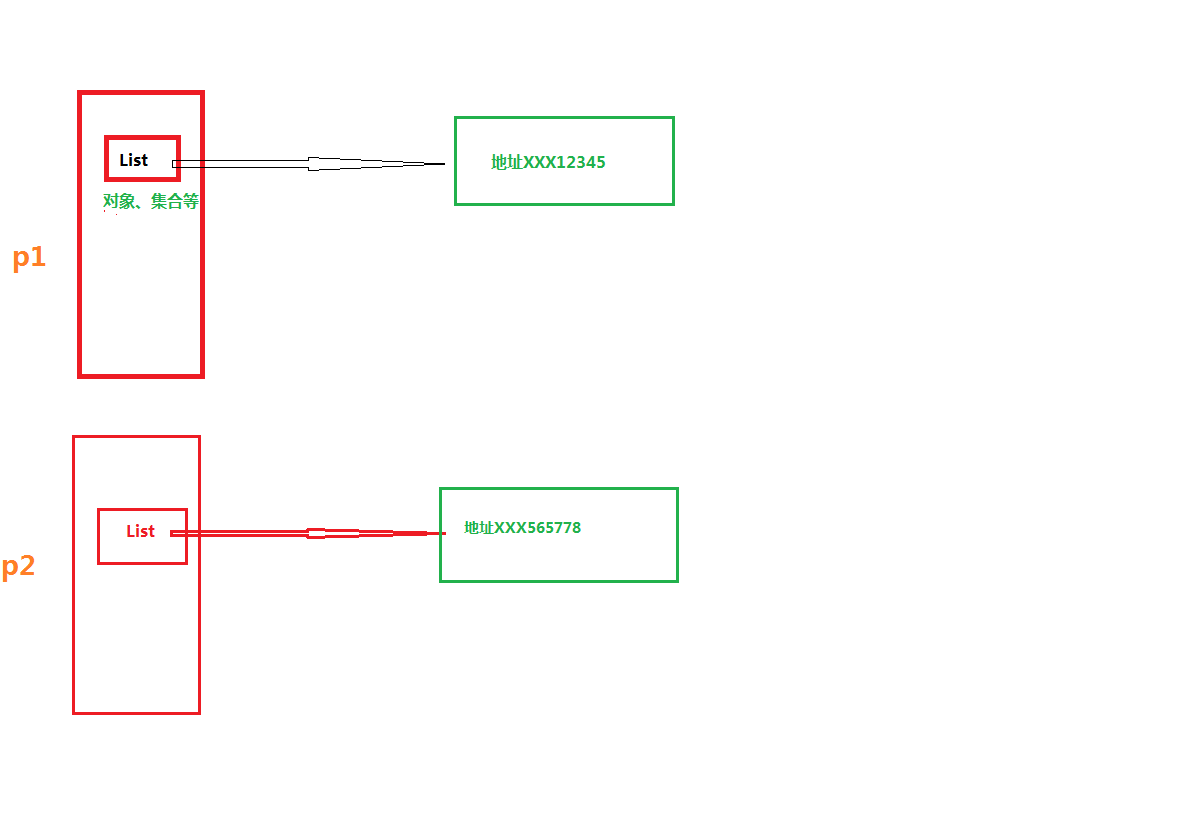Java设计模式之原型模式
2018-04-01 19:27
302 查看
原型模式(Prototype)
一、概述
二、结构
三、浅度克隆和深度克隆
浅度克隆
深度克隆一、概述
定义:原型模式属于对象的创建模式。通过给出一个原型对象来指明所有创建的对象的类型,然后用复制这个原型对象的办法创建出更多同类型的对象。简言之:就是复制粘贴。这就是原型模式的用意。
二、结构原型模式主要用于对象的复制,它的核心是就是类图中的原型类Prototype。Prototype类需要具备以下两个条件:1、实现Cloneable接口。在java语言有一个Cloneable接口,它的作用只有一个,就是在运行时通知虚拟机可以安全地在实现了此接口的类上使用clone方法。在java虚拟机中,只有实现了这个接口的类才可以被拷贝,否则在运行时会抛出 CloneNotSupportedException异常。2、重写Object类中的clone方法。Java中,所有类的父类都是 Object类,Object类中有一个clone方法,作用是返回对象的一个拷贝,但是其作用域protected类型的,一般的类无法调用,因 此,Prototype类需要将clone方法的作用域修改为public类型。三、浅度克隆和深度克隆
浅度克隆
只负责克隆按值传递的数据(比如基本数据类型、String类型),而不复制它所引用的对象,换言之,所有的对其他对象的引用都仍然指向原来的对象。
2
3
4
5
6
7
8
9
10
11
12
13
14
15
16
17
18
19
20
21
22
23
24
25
26
27
28
29
30
31
32
33
34
35
36
37
38
39
40
41
42
43
44
45
46
47
48
49
50
51
52
53
54
55
结果:
前后地址相同吗: false
输出p1:汤高 20
输出p2:汤高 20
输出p1:汤高 20
输出p2:周思远 19通过上诉测试可知对于基本类型和String类型的数据前后都是指向不同的地址空间,改变一个不会影响其他的对象浅度克隆图如下


但是如果包含引用类型比如对象、数组、集合等,就只会克隆引用,结果指向同一个引用地址
2
3
4
5
6
7
8
9
10
11
12
13
14
15
16
17
18
19
20
21
22
23
24
25
26
27
28
29
30
31
32
33
34
35
36
37
38
39
40
41
42
43
44
45
46
47
48
49
50
51
52
53
54
55
56
57
58
59
60
61
62
63
64
65
66
67
68
69
70
71
72
73
74
75
76
77
78
79
80
结果:
[汤小高, 周小思]
[汤小高, 周小思]
[汤小高, 周小思, TSY]
[汤小高, 周小思, TSY]
2
3
4
5
6
7
8
9
10
11
12
13
14
15
16
17
18
19
20
结果:
true
学校名: 清华
学校名: 清华
学校名: 北大
学校名: 北大我只改变了p1 结果p2也变了 原因如下图,共享一个引用浅度克隆图如下

这时候就需要使用深度克隆了!
深度克隆
除了浅度克隆要克隆的值外,还负责克隆引用类型的数据。那些引用其他对象的变量将指向被复制过的新对象,而不再是原有的那些被引用的对象。换言之,深度克隆把要复制的对象所引用的对象都复制了一遍,而这种对被引用到的对象的复制叫做间接复制。
深度克隆要深入到多少层,是一个不易确定的问题。在决定以深度克隆的方式复制一个对象的时候,必须决定对间接复制的对象时采取浅度克隆还是继续 采用深度克隆。因此,在采取深度克隆时,需要决定多深才算深。此外,在深度克隆的过程中,很可能会出现循环引用的问题,必须小心处理。要实现深度克隆 必须修改clone()方法
2
3
4
5
6
7
8
9
10
11
12
13
14
15
16
17
18
19
20
21
22
23
24
25
26
27
28
29
30
31
32
33
34
35
36
37
38
39
40
41
42
43
44
45
46
47
48
49
50
51
52
53
54
55
56
57
58
59
60
61
62
测试类同上结果:
[汤小高, 周小思]
[汤小高, 周小思]
[汤小高, 周小思, TSY]结果:
false
学校名: 清华
学校名: 清华
学校名: 北大
学校名: 清华
我修改了p1,p2的值没有改变 原因如下深度克隆图如下

博客转载于:https://blog.csdn.net/tanggao1314/article/details/50596042
一、概述
二、结构
三、浅度克隆和深度克隆
浅度克隆
深度克隆一、概述
定义:原型模式属于对象的创建模式。通过给出一个原型对象来指明所有创建的对象的类型,然后用复制这个原型对象的办法创建出更多同类型的对象。简言之:就是复制粘贴。这就是原型模式的用意。
二、结构原型模式主要用于对象的复制,它的核心是就是类图中的原型类Prototype。Prototype类需要具备以下两个条件:1、实现Cloneable接口。在java语言有一个Cloneable接口,它的作用只有一个,就是在运行时通知虚拟机可以安全地在实现了此接口的类上使用clone方法。在java虚拟机中,只有实现了这个接口的类才可以被拷贝,否则在运行时会抛出 CloneNotSupportedException异常。2、重写Object类中的clone方法。Java中,所有类的父类都是 Object类,Object类中有一个clone方法,作用是返回对象的一个拷贝,但是其作用域protected类型的,一般的类无法调用,因 此,Prototype类需要将clone方法的作用域修改为public类型。三、浅度克隆和深度克隆
浅度克隆
只负责克隆按值传递的数据(比如基本数据类型、String类型),而不复制它所引用的对象,换言之,所有的对其他对象的引用都仍然指向原来的对象。
public class Person1 implements Cloneable{
//基本数据类型
private int age;
//String引用类型
private String name;
public int getAge() {
return age;
}
public void setAge(int age) {
this.age = age;
}
public String getName() {
return name;
}
public void setName(String name) {
this.name = name;
}
public Person1 clone() {
Person1 person =null;
try {
person = (Person1) super.clone();
return person;
} catch (CloneNotSupportedException e) {
e.printStackTrace();
return null;
}
}
}
public class Client {
public static void main(String[] args) {
Person1 p1=new Person1();
p1.setName("汤高");
p1.setAge(20);
// Person p2=p1;//地址相同 只是把引用给了p2 指向同一个地址
// System.out.println(p1==p2);//true
Person1 p2=p1.clone();
//拷贝 地址不同了 指向不同的地址
System.out.println("前后地址相同吗: "+(p2==p1));
System.out.println("输出p1:" +p1.getName()+"\t"+p1.getAge());
System.out.println("输出p2:" +p2.getName()+"\t"+p2.getAge());
//修改拷贝后的对象的属性值
p2.setName("周思远");
p2.setAge(19);
System.out.println("输出p1:" +p1.getName()+"\t"+p1.getAge());
System.out.println("输出p2:" +p2.getName()+"\t"+p2.getAge());
}
}12
3
4
5
6
7
8
9
10
11
12
13
14
15
16
17
18
19
20
21
22
23
24
25
26
27
28
29
30
31
32
33
34
35
36
37
38
39
40
41
42
43
44
45
46
47
48
49
50
51
52
53
54
55
结果:
前后地址相同吗: false
输出p1:汤高 20
输出p2:汤高 20
输出p1:汤高 20
输出p2:周思远 19通过上诉测试可知对于基本类型和String类型的数据前后都是指向不同的地址空间,改变一个不会影响其他的对象浅度克隆图如下


但是如果包含引用类型比如对象、数组、集合等,就只会克隆引用,结果指向同一个引用地址
public class Person2 implements Cloneable{
//基本数据类型
private int age;
//String引用类型
private String name;
//引用类型
private List<String> friends=new ArrayList<String>();
//对象
private School school;
public School getSchool() {
return school;
}
public void setSchool(School school) {
this.school = school;
}
public int getAge() {
return age;
}
public void setAge(int age) {
this.age = age;
}
public String getName() {
return name;
}
public void setName(String name) {
this.name = name;
}
public List<String> getFriends() {
return friends;
}
public void setFriends(List<String> friends) {
this.friends = friends;
}
public Person2 clone() {
Person2 person =null;
try {
person = (Person2) super.clone();
return person;
} catch (CloneNotSupportedException e) {
e.printStackTrace();
return null;
}
}
}
public class Client2 {
public static void main(String[] args) {
Person2 p1=new Person2();
List<String> friends=new ArrayList<String>();
friends.add("汤小高");
friends.add("周小思");
p1.setFriends(friends);
Person2 p2=p1.clone();
System.out.println(p1.getFriends());
System.out.println(p2.getFriends());
friends.add("TSY");
p1.setFriends(friends);
System.out.println(p1.getFriends());
System.out.println(p2.getFriends());
School school=new School();
school.setName("清华");
}
}12
3
4
5
6
7
8
9
10
11
12
13
14
15
16
17
18
19
20
21
22
23
24
25
26
27
28
29
30
31
32
33
34
35
36
37
38
39
40
41
42
43
44
45
46
47
48
49
50
51
52
53
54
55
56
57
58
59
60
61
62
63
64
65
66
67
68
69
70
71
72
73
74
75
76
77
78
79
80
结果:
[汤小高, 周小思]
[汤小高, 周小思]
[汤小高, 周小思, TSY]
[汤小高, 周小思, TSY]
public class Client3 {
public static void main(String[] args) {
Person2 p1=new Person2();
School school=new School();
school.setName("清华");
p1.setSchool(school);
Person2 p2=p1.clone();
System.out.println(p1.getSchool()==p2.getSchool());
System.out.println(p1.getSchool());
System.out.println(p2.getSchool());
school.setName("北大");
p1.setSchool(school);
System.out.println(p1.getSchool());//北大
System.out.println(p2.getSchool());//北大
}
}12
3
4
5
6
7
8
9
10
11
12
13
14
15
16
17
18
19
20
结果:
true
学校名: 清华
学校名: 清华
学校名: 北大
学校名: 北大我只改变了p1 结果p2也变了 原因如下图,共享一个引用浅度克隆图如下

这时候就需要使用深度克隆了!
深度克隆
除了浅度克隆要克隆的值外,还负责克隆引用类型的数据。那些引用其他对象的变量将指向被复制过的新对象,而不再是原有的那些被引用的对象。换言之,深度克隆把要复制的对象所引用的对象都复制了一遍,而这种对被引用到的对象的复制叫做间接复制。
深度克隆要深入到多少层,是一个不易确定的问题。在决定以深度克隆的方式复制一个对象的时候,必须决定对间接复制的对象时采取浅度克隆还是继续 采用深度克隆。因此,在采取深度克隆时,需要决定多深才算深。此外,在深度克隆的过程中,很可能会出现循环引用的问题,必须小心处理。要实现深度克隆 必须修改clone()方法
public class Person2 implements Cloneable{
//基本数据类型
private int age;
//String引用类型
private String name;
//引用类型
private List<String> friends=new ArrayList<String>();
//对象
private School school;
public School getSchool() {
return school;
}
public void setSchool(School school) {
this.school = school;
}
public int getAge() {
return age;
}
public void setAge(int age) {
this.age = age;
}
public String getName() {
return name;
}
public void setName(String name) {
this.name = name;
}
public List<String> getFriends() {
return friends;
}
public void setFriends(List<String> friends) {
this.friends = friends;
}
//修改后的clone方法
public Person2 clone() {
try {
Person2 person = (Person2) super.clone();
if(this.getFriends()!=null){
List<String> friends=new ArrayList<String>();
for(String friend:this.getFriends()){
friends.add(friend);
}
person.setFriends(friends);
}
if(this.getSchool()!=null){
School school=new School();
school.setName(this.getSchool().getName());
person.setSchool(school);
}
return person;
} catch (CloneNotSupportedException e) {
e.printStackTrace();
return null;
}
}
}12
3
4
5
6
7
8
9
10
11
12
13
14
15
16
17
18
19
20
21
22
23
24
25
26
27
28
29
30
31
32
33
34
35
36
37
38
39
40
41
42
43
44
45
46
47
48
49
50
51
52
53
54
55
56
57
58
59
60
61
62
测试类同上结果:
[汤小高, 周小思]
[汤小高, 周小思]
[汤小高, 周小思, TSY]结果:
false
学校名: 清华
学校名: 清华
学校名: 北大
学校名: 清华
我修改了p1,p2的值没有改变 原因如下深度克隆图如下

博客转载于:https://blog.csdn.net/tanggao1314/article/details/50596042
相关文章推荐
- 7.java设计模式(读书笔记)原型模式
- Java进阶篇设计模式之三 ----- 建造者模式和原型模式
- java设计模式(2)——原型模式
- java设计模式第13弹--原型模式
- java设计模式--原型设计模式 Prototype
- 《学习笔记》之JAVA设计模式--原型模式
- java设计模式之原型模式
- Java设计模式——原型模式
- JAVA设计模式之原型模式
- Java设计模式---原型模式(Prototype)
- java设计模式学习笔记-原型模式
- 【java】java设计模式(5):原型模式(Prototype)
- 设计模式之第9章-原型模式(Java实现)
- Java设计模式之原型模式(Prototype模式)介绍
- java设计模式之原型模式
- java 设计模式学习笔记(8) - 原型模式
- java设计模式之原型模式
- java设计模式之原型设计模式
- Java设计模式(七):原型模式
- java设计模式--原型设计模式 Prototype
